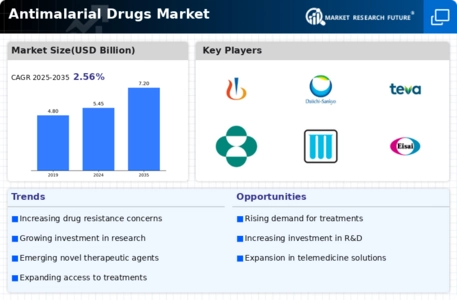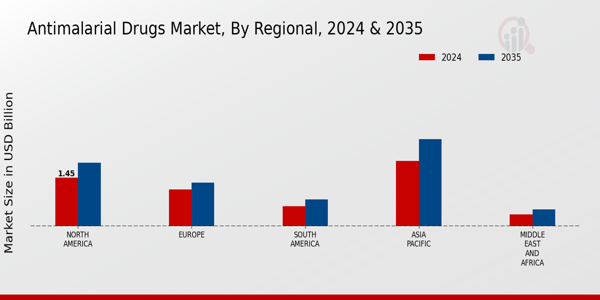Rising Incidence of Malaria
The Global Antimalarial Drugs Market Industry is experiencing growth due to the rising incidence of malaria, particularly in tropical and subtropical regions. According to the World Health Organization, there were an estimated 241 million cases of malaria worldwide in 2020, with a significant burden in Africa. This persistent prevalence drives the demand for effective antimalarial treatments, contributing to the market's projected value of 5.45 USD Billion in 2024. The ongoing need for innovative therapies and preventive measures is likely to sustain this upward trajectory, as healthcare systems strive to combat malaria effectively.
Market Trends and Projections
The Global Antimalarial Drugs Market Industry is characterized by various trends and projections that indicate its future trajectory. As of 2024, the market is valued at 5.45 USD Billion, with expectations of reaching 7.2 USD Billion by 2035. This growth reflects a CAGR of 2.56% from 2025 to 2035, driven by factors such as rising malaria incidence, government funding, and advancements in drug development. The market dynamics suggest a robust demand for antimalarial treatments, influenced by ongoing research and public health initiatives aimed at combating malaria effectively.
Advancements in Drug Development
Advancements in drug development are significantly influencing the Global Antimalarial Drugs Market Industry. The emergence of novel therapeutic agents, such as artemisinin-based combination therapies, has revolutionized malaria treatment. These innovations are driven by ongoing research efforts and collaborations among pharmaceutical companies and academic institutions. As a result, the market is projected to grow at a CAGR of 2.56% from 2025 to 2035, reflecting the potential for new drugs to enhance treatment efficacy and reduce resistance. The continuous evolution of antimalarial therapies is essential for addressing the challenges posed by drug-resistant malaria strains.
Increased Awareness and Education
Increased awareness and education regarding malaria prevention and treatment are pivotal for the Global Antimalarial Drugs Market Industry. Public health campaigns aimed at educating communities about malaria transmission and the importance of seeking treatment have been instrumental in reducing malaria cases. Organizations like the World Health Organization actively promote awareness initiatives, which encourage the use of antimalarial drugs. This heightened awareness is likely to drive market growth, as more individuals seek effective treatments. As the global community continues to prioritize malaria eradication, the demand for antimalarial drugs is expected to rise, further supporting market expansion.
Government Initiatives and Funding
Government initiatives and funding play a crucial role in the Global Antimalarial Drugs Market Industry. Various countries are implementing strategic plans to combat malaria, which include financial support for research and development of new antimalarial drugs. For instance, the Global Fund to Fight AIDS, Tuberculosis and Malaria has allocated substantial resources to enhance access to effective treatments. This commitment is expected to bolster the market, as evidenced by the anticipated growth to 7.2 USD Billion by 2035. Such initiatives not only facilitate the development of new drugs but also improve distribution channels, ensuring that effective treatments reach those in need.
Emerging Markets and Economic Growth
Emerging markets and economic growth are contributing factors to the Global Antimalarial Drugs Market Industry. Countries with improving economies are increasingly investing in healthcare infrastructure, leading to enhanced access to antimalarial treatments. For instance, nations in sub-Saharan Africa are experiencing economic development, which facilitates the procurement and distribution of essential medicines. This trend is expected to bolster the market, as the demand for effective antimalarial drugs rises in these regions. The combination of economic growth and increased healthcare spending is likely to support the market's expansion, aligning with the projected growth to 7.2 USD Billion by 2035.
























